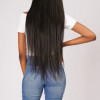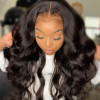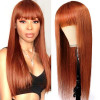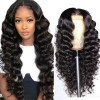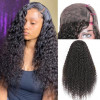Human Hair Wigs: Everything You Must Know
Are you someone who is just starting out in the wig industry? If so, how?
Then this site will assist in answering any queries you might have about wigs. You'll learn everything about why, how, what sorts exist, and how to take care of them. Find all the answers to your inquiries about human hair wigs by reading on!
Hair accessories called wigs are created from synthetic or human hair.It is worn for convenience, aesthetics, or prosthetic purposes.
People with hair-related issues like alopecia, spot baldness, or hair thinning can use wigs to conceal their condition. Individuals use it to achieve longer, fuller hair or hair that is a different hue than their natural hair for cosmetic reasons. Additionally, using wigs to modify your look on occasion is really convenient.
The History of Hairstyles
Some anthropologists claim that wigs originated 100,000 years ago. People in ancient Egypt who shaved or chopped their hair short for comfort and cleanliness—as a way to escape the scorching desert heat—were known to wear wigs. There is a wig at the British Museum that dates back around 3,000 years.
The 17th century saw the introduction of wigs into British courtrooms. It was fully accepted, along with robes, as legal dress. Smaller bench wigs were worn in the courtroom by judges who wore long, curly, full-bottom wigs.
Different Types of Wigs
Wigs have developed into a necessary piece of clothing for ladies over time. The quality of wigs has taken a while to perfect, but the wigs of today are nearly indistinguishable from your own hair.
A significantly greater percentage of women are experimenting with wigs. There are numerous options available in terms of textures, colors, styles, and lengths. You may go from plain to stylish in a matter of minutes, and it saves you time and energy.
Based on the type of hair, construction, variations, styles, and application, wigs come in a broad range. We will be happy to assist you in understanding this fascinating and practical accessory and delving into the world of wigs.
Based On Hair Type
Essentially, wigs are made of two types of hair: synthetic and natural. Synthetic wigs are constructed of nylon or acrylic fibers, whereas natural hair wigs are made entirely of human remy hair.
Human Hair Wigs
Human hair wigs are the best quality available. They will assist you in obtaining the most organic appearance and texture.
When wearing real hair wigs, you are free to style your hair anyway you choose.
Compared to synthetic fiber wigs, these wigs are stronger and have a longer lifespan. All you need to do is give them some affection and love.
Although human hair wigs cost more than synthetic ones, their appearance is more authentic.
Just like you would with your hair, you can wash, style, and color them.
Synthetic Wigs
Synthetic wigs mimic the texture and appearance of real hair and are constructed from acrylic or nylon fibers.
They are available in different hues and styles. There are numerous alternatives available to you, and they are already styled.
They can hold their form and elegance for an extended period of time.
You cannot apply heat to synthetic wigs as they tend to lose their structure and form and cannot be restyled to your preference. They are prepared for wearing.
Since they are usually less expensive than human hair wigs, they must also be less durable.
Wig Construction
The cap, or foundation, and the hair are the only two basic components, making wig creation simple. The foundation, often known as the cap, is just the wig's basic material. The hair is machine-constructed or sewed onto a structure that resembles a real head. In order to keep it in place, this piece is then fastened to the wearer's head.
Human hair or artificial hair, often known as synthetic hair, can be used for wigs. The hair is either manually applied to the wig or affixed to it with a machine that ensures it stays in place. But if needed, stitches can also be strengthened by glue.
Full Cap Wig
An excellent option for finishing off a natural head of hair is a full-cap wig.
The hair of a full-cap wig is sewed into the fabric and fully covered by the cap, which is also known as a full caul or netting cap.
A full cap offers greater coverage as it wraps around the entire circumference of the forehead and ears as opposed to a half or 3/4 cap.
One benefit of this kind of wig is that, from the outside, there are virtually no spaces between the hair and scalp, therefore there are no visible part lines.
Due to its closed structure, a full-cap wig may not breathe as well as other varieties and can feel warm when worn for lengthy periods of time.
Open Cap Wig
We join wefts of hair to make the cap of an open cap wig, also known as a capless cap, wefted cap, basic wig cap, or wefted wig.
You won't have to worry about trying to flatten it out by yourself because it is machine-made.
Wefting is barely noticeable because to the permatease method, which also preserves the desired aesthetic.
This wig is perfect for those who find wigs too hot in the summer. Air can easily flow up and out from underneath it. This helps keep the wearer cool.
Partial Coverage Wig
A partial coverage wig (also known as a wiglet) is designed to accentuate a person's natural hair and might be an elastic structure or clip-on wig.
You can use accessories to create a stylish ponytail or bun without wearing a full wig. Adding extra pieces of hair can make your hair look longer or thicker."
Another kind of partial wig that covers only the back of the neck and the crown is called a topper cap. It is fastened to the wearer's head with clips.
For people who suffer hair loss in certain regions and wish to always look well without losing their natural appearance, this is fantastic.
In order to blend in what little hair a person does have, there are also partial wigs on the market that stop short of the forehead.
Method Of Production
There are primarily two ways that wigs are made. By machine, the other by hand.
Hand-tied Wigs
Although the hand-tied wig method takes a lot of time, it looks more natural than spray-painting since each head of hair is tied individually. The hair on this type of wig may be separated in any way and flows in one direction, making it appear more natural. When determining whether or not using a hand-tied wig would be a good alternative, a lot relies on personal finances and time limits.
Machine-made Wigs
The machine-made wig is another kind of wig. People who are allergic to wig tapes and glues frequently wear machine-made wigs. These wigs are popular with beginners because they don't need glue or chemicals to stay in place." Additionally, machine wigs are less expensive than other kinds.
Special Wigs
A select few specialist wigs are currently dominating the market. To understand what they are, let's discuss them in greater detail.
U-Shaped Wig
The U-shaped Wig is delivered as a single piece with a hole for your natural hair to pass through. This is comparable to weaving one's hair through a weave to get a weaved look.
This style may not work well for people with short or thin hair. The long hair strands on the wig may not blend well with different textures. This can result in a less full appearance. Alternatively, a full coverage wig is ideal if you prefer a "wig-with-weave" look with densely woven strands.
Full Lace Wig
Full lace wigs pull individual hair strands through the elastic cap to create the most realistic and natural-looking hairline possible. Because it is washable and styleable, and because the lace designs may be modified to your preference, it is regarded as the most natural of all wigs.
The problem with this option is that because it is delicate and prone to tearing, it needs to be handled carefully throughout the application procedure. In order to avoid harming actual hair strands, it must also be handled carefully.
Lace Front Wig
This kind of wig is ideal if you want an exceptionally natural hairline. Styling your hair away from your face regularly is very effective. Traditional lace front wigs have an artificial hairline that goes halfway down the forehead. This cap structure allows you to create a natural-looking wig all the way to the hairline.
You don't have to bother about cutting or shortening the piece yourself because many of our lace front wigs arrive to us ready to wear and cover your head from temple to temple.
Closure
Those who wear wigs or hairpieces often opt for closures. In order for someone to wear a hairpiece covertly, closures—real or synthetic hair—are sewed onto the front portion of the piece. On occasion, it's also utilized to conceal the underlying hairstyle.
Although these closures come in a variety of forms and sizes, they are typically 4 x 4 inches in size. This is a very flexible addition to help you create a customized look because they can be styled and parted in one or both directions.
Silk Top Wig
If you want something that seems really authentic and natural, this is the greatest wig. People won't believe it's coming from beneath your scalp because it fits in with your hair so perfectly!
To create that flesh-tone appearance, the bundles feature a silk top and realistic-looking knots hidden beneath a second layer. This is also quite versatile in terms of styling and would look fantastic on a variety of facial shapes. Because the knots would show, this cannot be worn off to one side or in a high ponytail. You can use combs or hairdresser clips to fasten this on the back.
Half Wig
A half wig is a hairpiece that is secured with combs or clips. It goes halfway down the head, just above the ears. This hairstyle provides good coverage on the top without being too bold or sharp, and also adds volume and length. Women who wish to give the appearance of longer hair without completely covering up their natural hair are drawn to this.
%20(1)-1841x1841.jpg)


